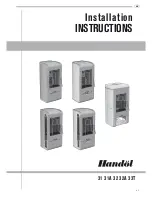
16
1
1.
Shaker grate
2.
Log retainer
3.
Vermiculite
4.
Ash pan
5.
Cast iron door
6.
Top plate
7.
Air rosette for kindling air
8.
Secondary air damper
9.
Throttle for shaker grate
10.
Tertiary air beam (tertiary airflow)
11.
Flue collar
12.
Magnet for base cover, can vary depending on model
2
3
4
5
6
7
Aura 1, 2, 3, 11 and 3 Stone 11
Overview of loose parts
8
10
9
11
12
9
General advice and instructions are available on the Varde Ovne website.
Floor material:
If the stove is to stand on a flammable floor, then the floor area on which it stands must
naturally be covered by a non-combustible material, e.g. a steel sheet, glass sheet, tiles or
artificial slate sheet. The floor sheet must extend by at least 15 cm out from the sides of the
stove and at least 30 cm out from the front. However, we recommend 50 cm in front of the
stove.
The floor structure must also be able to support the stove and if required, the chimney’s total
weight.
Installation distances:
If the wall is non-combustible, the stove may be positioned next to it. However, we recommend
that you keep a gap of 5–10 cm, which will mean that you will be able to clean behind the stove.
If the chimney cleanout access door is behind the stove, make sure there free access to it and
there is enough space to clean the chimney thought it.
Installing the stove in relation to combustible material.
It is recommended that there is a distance of 22.5 cm from the outer edge of the flue to any
combustible material. Please note that there may be other national and local regulations relating
to the distance to combustible material. Contact your local chimney inspector for advice.
The stove’s individual distance to combustible material is shown on page 10 or under the
technical data.
Stove
Weight in kg
Aura 1
104
Aura 11
113
Aura 2
104
Aura 3
104
Aura 3 Stone
190
Fresh air supply
In the room where the wood-burning stove is to be installed, you must ensure that there
is sufficient fresh air supply. Combustion only works effectively when new air is
constantly supplied to the fire.
This can be achieved, for example, by installing room ventilation valves in the walls.
It must not be possible to block these air grates.
The combustion requires airflow of approx. 14-20 m³/h.






























